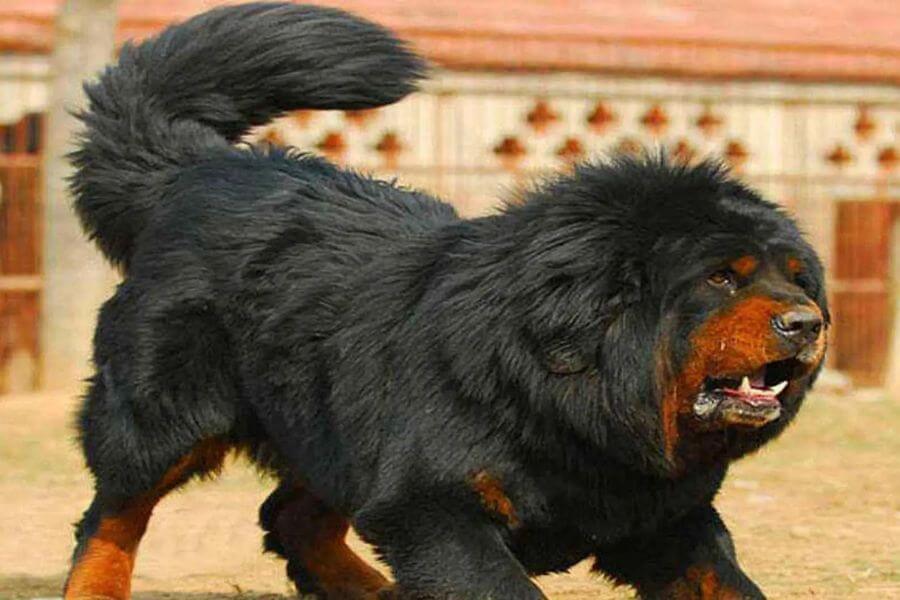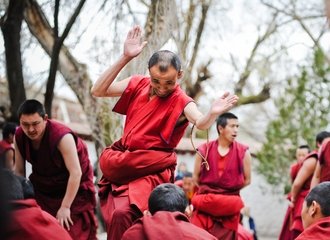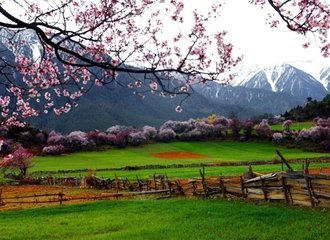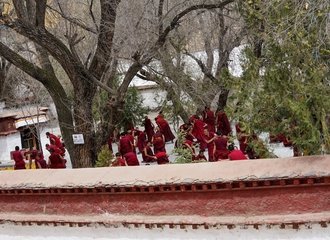Face to face with Tibetan Mastiffs at Yamdrok Lake!

When we stepped out of our car near Yamdrok Lake in Tibet, what surprised me the most was not the imposing snow-capped Himalayan mountains or the vibrant blue alpine lake, but a group of strange, huge, black dogs! I was bitten by a dog when I was young, so obviously I hesitated to touch them when they came up to sniff my clothes, and in fact, (I am a little embarrassed to admit) I screamed and asked their keeper to get them away!
Their keeper smiled at me and showed me that the dogs were safe, and invited me to take a photo with them. As it turned out, the dogs were gentle and obedient, letting me stroke their thick fur while they looked at me with their big, beautiful eyes.
I was curious about these intimidating-yet-gentle dogs, so I asked our guide, who told me an interesting story. That kind of dog is called a ‘藏獒’ (Zang'Ao), which literally means 'Tibetan big ferocious dog' or 'Tibetan Mastiff'. Legend has it that they were once the Gods of War in heaven, but they broke some of the celestial rules and were sent to earth as dogs, in punishment.
Mastiffs are born ferocious and aggressive, so much so that 2 mastiffs together have the ability to confront larger predators such as wolves and leopards. However, in Tibet, when mastiff pups are around 49 days old they are penned together with sheep to soften the mastiff’s aggressive nature - if the dog can get along well with sheep, then the obedience training has been successful!
Successfully-trained Tibetan mastiffs will become family mastiffs, working as guardians for Tibetan families' all-important herds of livestock, homes, villages, and even monasteries or palaces. These colossal dogs have incredible strength and ferocity, yet they can be trained to restain themselves with such discipline. A well-trained mastiff may be sold for as high as 5,000 RMB, while poorly behaved ones that kill a lot of sheep and refuse to heel during training will be sold for a very low price or even be put down.
After learning all this, I actually began to wish that I had one such well-trained mastiff for my own!
More about Tibetan Mastiff
Tibetan Mastiff origins are from the nomadic cultures of Tibet, China, Nepal, and India. The Tibetan Mastiff has been bred by local tribes and monks for centuries to protect sheep from predators like wolves and leopards. Their history is steeped in the mythology of being celestial guardians, which adds a mystical aura to their already impressive stature. This lore complements their natural protective instincts, making them not only pets or working animals but also symbolic guardians of their owners' homes and livelihoods.
Physical Characteristics
The Tibetan Mastiff's physical characteristics are as impressive as their legendary backstory. They possess a thick, double coat that can be black, brown, gold, or blue-gray, designed to protect them from the harsh Tibetan climate. Their mane-like fur around the neck and shoulders gives them a lion-like appearance, further enhancing their formidable look. Despite their size, they are known for their agility and strength, capable of moving quickly to defend their territory or herd.
Tibetan Mastiff’s temper
Their training and socialization are crucial elements in their upbringing. The traditional method of integrating them with sheep at an early age serves a dual purpose: it tempers their aggressive tendencies and instills a protective instinct towards the animals they grow up with. This method showcases a profound understanding of animal behavior and training by the Tibetan people, emphasizing harmony and balance between nature and the needs of their community.
The Tibetan Mastiff's role extends beyond just being a guardian of livestock. They are considered part of the family, a symbol of status and wealth, and in some cases, a spiritual protector. Their presence in monasteries and palaces is not only for protection but also as a spiritual symbol, representing loyalty, strength, and the protective nature of the Buddhist teachings.

Reflecting on my encounter with these majestic creatures near Yamdrok Lake, I realized that the Tibetan Mastiff embodies the spirit of Tibet itself: rugged, mystical, and imposing, yet capable of gentle loyalty and profound connection with those they protect. This experience not only alleviated my fear but also left me with a deep respect for these dogs and the culture that has shaped their existence. As I bid farewell to the Tibetan plateau, the image of the gentle giants against the backdrop of the Himalayas lingered in my mind, a vivid reminder of the beauty and complexity of life in this remote part of the world.














